Last week, we started looking at the musicians on Wikipedia’s list of the longest gaps between albums:
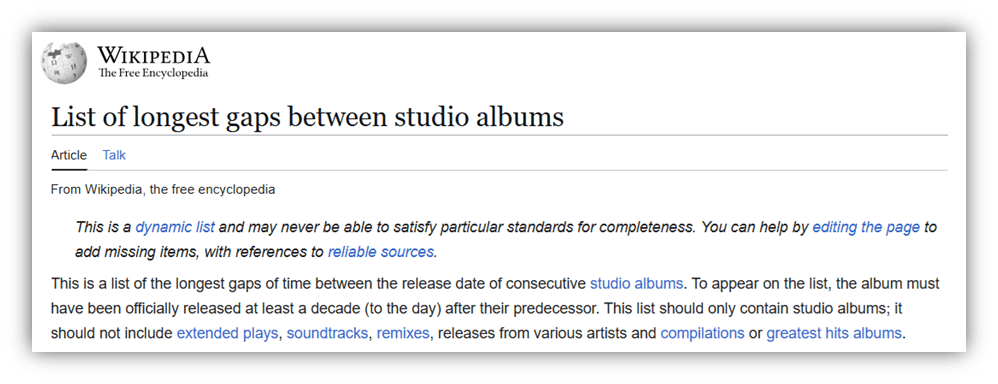
We got through #10 through #6.
Here now are the Top 5. There are a couple names you’ve heard before, but the lesser known ones have interesting stories, too.
#5: 49 Years:
Fresh Maggots:


Fresh Maggots (1971…)

Waiting for the Sun (2020)

British Folk duo Fresh Maggots got their questionable name from a sign in a sports shop selling bait.
Mick Burgoyne and Leigh Dolphin were from Nuneaton, UK and had met through mutual friends. A music publisher happened to see their second gig and that led to their 1971 self-titled album.

They were only about 19 years old.
The strange but compelling album mixes gentle acoustic songs with flashes of fuzz guitar, tin whistle, and other unexpected instruments. After the record failed to sell, the pair drifted into ordinary lives and other work. For decades, the album lived on through reissues and word of mouth. It became a cult collector’s item, and curious new fans found it.
Burgoyne and Dolphin remained friends and a long, quiet revival began after renewed press interest in the 2000s, and especially after a German magazine interview in 2017. Burgoyne and Dolphin started writing again and released Waiting for the Sun in October 2020 — 49 years after their first album. That huge gap is part of their charm:
Two teenage friends made a beloved record, went away to live their lives, and reunited decades later.

Recommended Listening
- “Dole Song” (1971)
- “I’m Getting Old“ (2023)
#4: 52 Years:
Alice Cooper:


Muscle of Love (1973…)

The Revenge of Alice Cooper (2025)
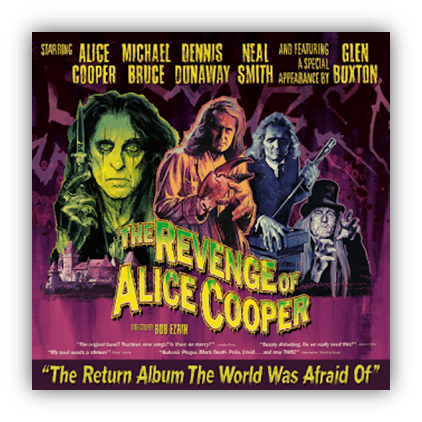
This one confused me.
Alice Cooper was always around, and new albums came out regularly. Then I remembered:

- There’s Alice Cooper, the singer,
- And Alice Cooper, the band.

The band formed in Phoenix, AZ in the late 1960s with a raunchy mix of Hard Rock and horror theater. They made a string of gold, silver, and platinum albums — Love It to Death, Killer, School’s Out, Billion Dollar Babies — and then released Muscle of Love in 1973, the last studio album by the original group before they broke up. It looks like each member had their own reason, ranging from burnout to disagreements about money.
Alice Cooper, the singer, went solo.
He kept the shock-rock persona and had a hit with “Welcome to My Nightmare” in 1975, while the other players scattered into side projects, session work and occasional reunions.

Guitarist Glen Buxton died of viral pneumonia in 1997, a week after performing with other ex-bandmates.
The original members popped up on a few of Cooper’s later solo records and joined in for special live shows over the years.

The band was inducted into the Rock & Roll Hall of Fame in 2011.
Just a few months ago in 2025, the remaining original band returned to the studio for the first time in 52 years, releasing The Revenge of Alice Cooper — a reunion that the members described as “picking up where they left off.”
That huge gap shows that a band’s spark can survive decades.

Recommended Listening:
- “Teenage Lament ‘74” (1973)
- “Black Mamba” (2025)
#3: 53 Years:
MC5:
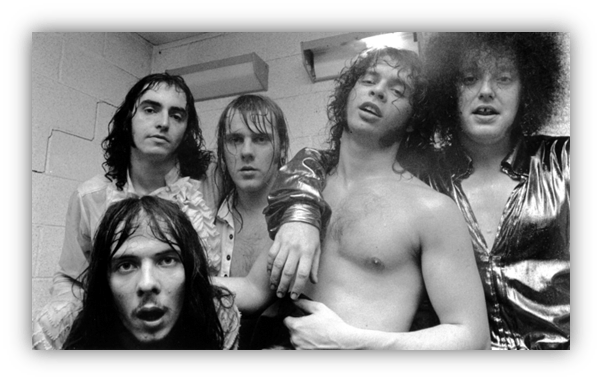

High Time (1971…)

Heavy Lifting (2024)

“MC5” stands for “Motor City Five,” and the band was indeed from Detroit.
They formed in the late 1960s as a furious, political Rock band — energetic, loud, and raw. Their classic run produced three records close together: the live blast Kick Out the Jams (1969), the studio firecracker Back in the USA (1970), and High Time (1971).
Alongside Detroit’s Iggy & The Stooges, they’re considered Punk godfathers.
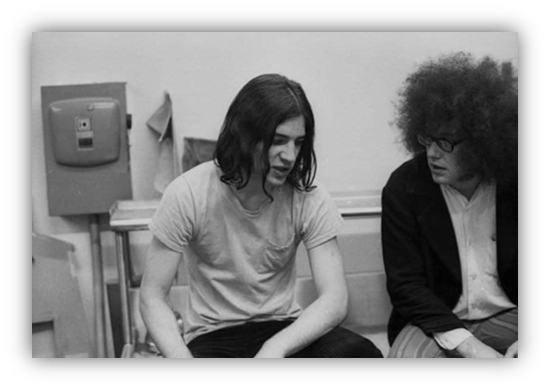
After 1972 the original group fell apart and the members scattered into very different lives.
- Singer Rob Tyner formed Rob Tyner & the National Rock Group who played many shows but never recorded. He died of heart failure in 1991.
- Guitarist Fred “Sonic” Smith formed new bands and later married Patti Smith. He too died of heart failure in 1994.
- Drummer Dennis Thompson played with numerous bands in Los Angeles, Australia, and, of course, Detroit.
- Guitarist Wayne Kramer struggled with addiction, went to prison for selling drugs, then rebuilt a career as a solo artist and prison-arts activist. He also appeared on a couple of Was (Not Was) records.
- Bassist Michael Davis joined experimental outfits like Destroy All Monsters, and also served time on drug charges.

The three surviving members sometimes reunited for shows in the 2000s.
They announced a new album in 2022 and began recording, but all three had passed away by the time it was released. Heavy Lifting came out in October 2024 — 53 years after High Time.
Their long gap isn’t a mystery so much as indicative of Rock’s hard life: initial success, burnout, politics, prison, other bands, reunions, and finally,
A posthumous record that underlines how a band can be influential long after they’re gone.

Recommended Listening:
- “Sister Anne“ (1971)
- “Heavy Lifting” feat. Tom Morello (2024)
#2: 57 Years:
Napoleon XIV:
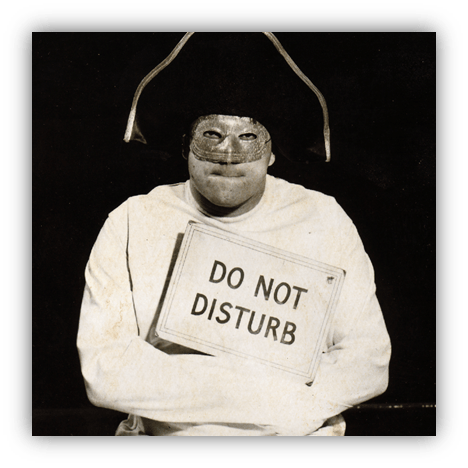

They’re Coming to Take Me Away, Ha-Haaa! (1966…)

For God’s Sake, Stop the Feces! (2024)

Songwriter and producer Jerry Samuels — better known by his oddball persona Napoleon XIV — keeps surfacing on one-hit-wonder lists.
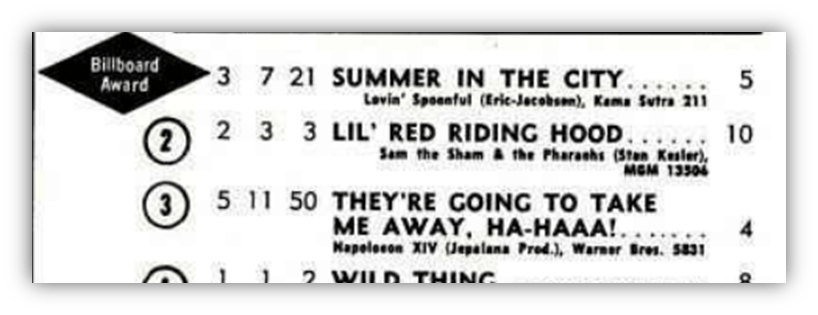
In 1966, he wrote and recorded “They’re Coming to Take Me Away, Ha-Haaa!”, which reached the Top 5 in the US, the UK, Canada, and Australia.
(The B-side of the 45 single was the same recording:)

(- but backwards.)
That year also saw a full Napoleon XIV album of the same name, which kept the same “insane” theme. Samuels didn’t ride pop stardom into a long recording career but the single became a novelty classic.
Prior to his hit, Samuels co-wrote “As If I Didn’t Know,” a top-10 hit for Adam Wade in 1961 and wrote “The Shelter of Your Arms” for Sammy Davis Jr. in 1964.
After his 1966 moment on the charts, he wrote songs under various names, produced other artists, and ran a talent-booking agency he started in the 1980s.
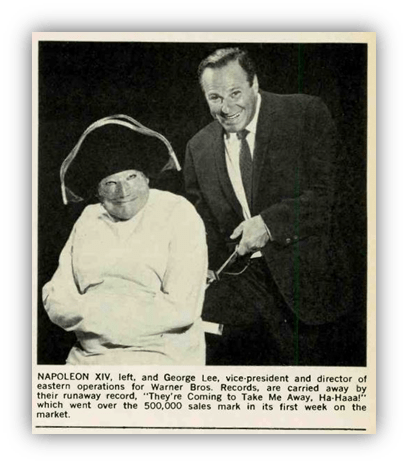
He sometimes revisited the Napoleon XIV persona for odd singles and demos, but mostly he focused on songwriting and booking.

A second studio album recorded between 1968 and 1970 was rejected for its dark content. No one at the label saw humor in rape and suicide. The album only saw an official release decades later in 2023, two years after Samuels’ death.
That means there’s a 57-year span between releases, though that second album was recorded not long after the first. Should we count it on the list of longest gaps? Well, Wikipedia does, so I include it here, but discuss it amongst yourselves.
Recommended Listening:
- “They’re Coming to Take Me Away, Ha-Haaa!” (1966)
- “I Owe A Lot To Iowa Pot” (1970 or 2023,depending)
#1: 57 Years:
Dean Gitter:
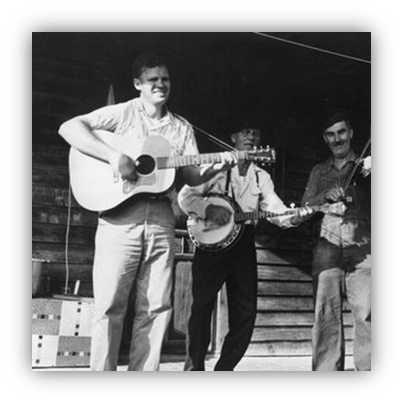

Ghost Ballads (1957…)

Old Folkies Never Die (2014)

Dean Gitter was one of those people who lived two lives at once — as a tasteful Folk musician and a restless entrepreneur.
In music, he’s best known for 1957’s Ghost Ballads, a collection of spooky old songs, and for returning to the studio in 2014 for Old Folkies Never Die. That’s 57 years, the longest ever gap between studio albums.
What did he do in between? Plenty.
Early on he worked behind the scenes in the Folk revival. He produced records, including Odetta Sings Ballads and Blues, a crucial album in the scene and one of Bob Dylan’s favorites.
Gitter then moved into film and local media, helping open the Orson Welles Cinema in Cambridge, MA in 1969 and launching regional TV ventures.


For years he focused on real estate development in the Catskills, building the Emerson Resort & Spa and financing Kaatskill Kaleidoscope, the world’s largest kaleidoscope.
He also promoted the enormous Belleayre Resort plan, but it was delayed for years and greatly reduced in scale due to local protest against its detrimental environmental impact.
He kept tinkering in music, writing songs and later setting Carl Sandburg poems to music. In later life, he lived on a New Mexico farm, raised horses, and played with local musicians. He died in 2018, four years after his second album.
Recommended Listening:
- “Anne Boleyn” (1957)
- “Ride Around Little Dogies” (2014)
With the possible exception of Napoleon XIV:
These long gaps between albums are reminders that creative work can pause for decades, and that a comeback doesn’t need to follow anyone else’s timetable. Creativity itself never ends. It changes as each person changes, so there’s hope for all of us.
So I’m no longer feeling antsy that I haven’t been on a record for five years.






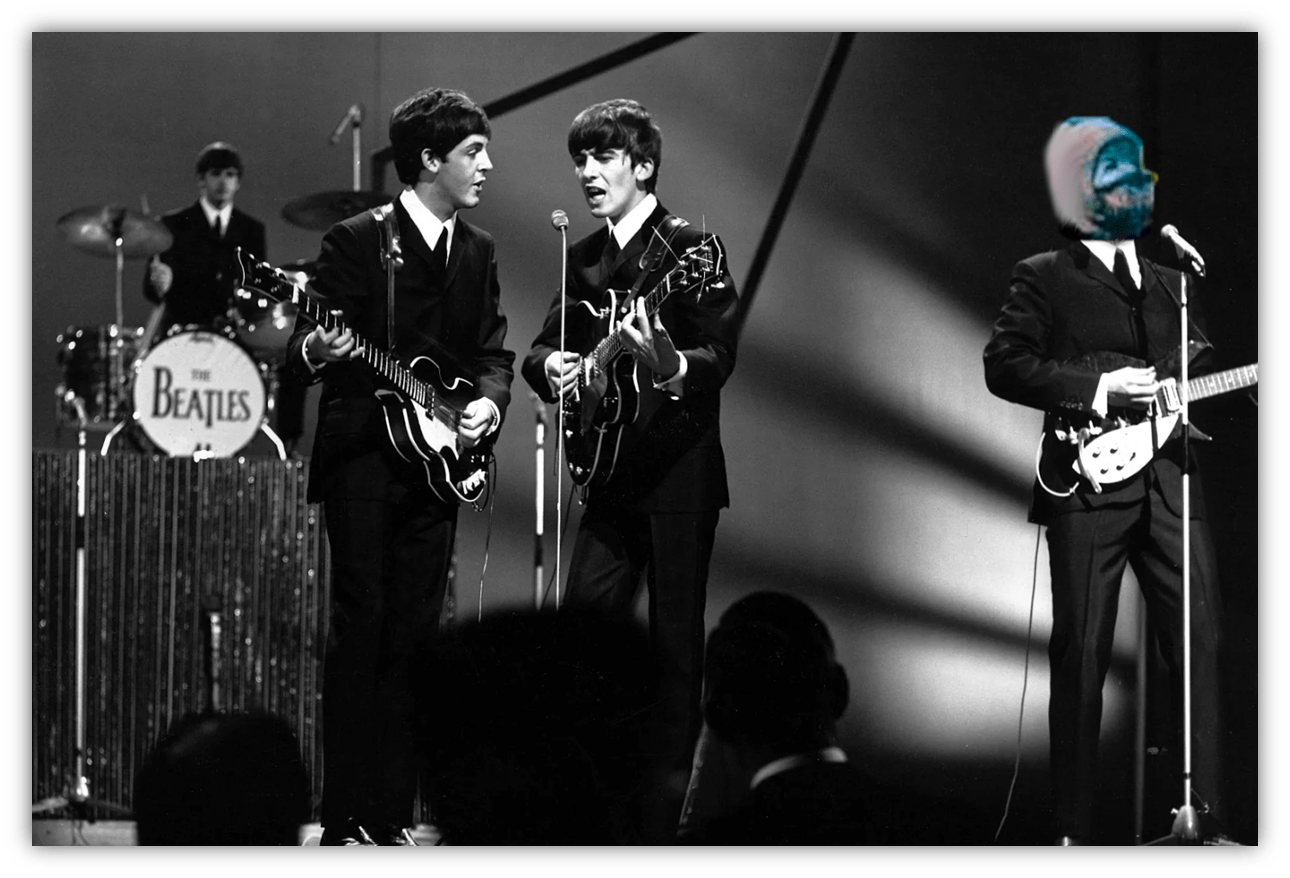



Inspiration for some of us folks of a certain age that it’s never too late to do what you love.
You almost had me with the dual Alice Coopers. I was like, hey wait a minute here, and then ahhh.
It’s the same reason you shouldn’t name your kid after you. You’d end up calling him Junior just to avoid confusion.
I think it was the reverse. The band name Alice Cooper came first and Vincent Furnier was just himself, but everyone assumed his name was Alice Cooper since he was the lead singer so he just went with it and eventually legally changed his name.
My dad was a junior and hated it for the reasons you stated, so we all got our own names and none of us were “the third”.
I’m the “fourth”. Although over here we don’t tend to add the number (unless you’re the monarch) or use ‘junior’ to differentiate. I think being referred to as junior would have grated on me too. I don’t remember it ever getting confusing other than the GP and dentist sometimes mixed up my dad and grandad.
My great grandad died when I was four so we only had a brief period of all four of us being around together. Someone should have got a photo of all of us together but too late now. Still, my wife and I were very certain that if we’d had a boy there would be no “the fifth”.
My father, grandfather, and I share the same first name but have different middle names. It was confusing when the phone rang and people asked to talk to Bill, and even more confusing when puberty hit and my friends’ voices dropped.
Which one’s Hootie?
I was thinking The MC5s should have an asterisk due to only 60% of the band making it to the other side of the great divide. Getting a full complement back together feels more impressive. Though maybe that’s mean spirited as they had good reason not to be present. Then the fact that none of them lived to see the album release makes it even sadder.
Fortunately Fresh Maggots is more uplifting. Not a sentence that one expects to write.
As I saw the article come up today a couple of names came to mind; The Stooges and Vashti Bunyan. Looked up the wiki link and both had a 34 year gap. Lengthy but only enough to rank around 60th.
I thought about that, too, and that Alice Cooper the band was only at 80% being there. Still, I don’t want to take anything away from the surviving members. They deserve a tip of the hat.
The lovely Ms. Virgindog said yesterday that she’s not going to try to make it on the list because she hasn’t even released her first album yet. Or learned how to play an instrument.
This made me wonder about another record; oldest person to release a debut album.
Turns out that just this year the record was extended from 89 to 100. 100 years and 265 days to be precise. After 70 years in the business and appearing on other people’s records, jazz musician Marhsall Allen released his debut album under his own name.
Ms. Virgindog has decades yet to learn an instrument and get in the record books by waiting til she passes the century mark before recording her debut.
I have an accordion I never play so I just offered it to her. She said she could be the Grandma Moses of accordion.
I gotta admit, as much as “They’re Coming to Take Me Away, Ha Ha!” can grate on my nerves sometime, “I Owe a Lot to Iowa Pot” may well be the best new music title I’ve heard in a long time.
I looked this up. Something sitting on the periphery of memory while reading your Alice Cooper entry. P.J. Harvey was originally a band. They were called the P.J. Harvey Trio, although the cover art for Dry and Rid of Me doesn’t indicate this.
Alice Cooper is a good deejay. I started listening to FM radio again when the station who aired his show still had money.
A fun article! I’m glad the guy who won first doesn’t have an asterisk by his name like Napoleon XIV. (Incidentally, that picture of the guy with the washboard and drumsticks is Spike Jones of 1940s-50s novelty record fame. I’m guessing there may not be a lot of Napoleon XIV photos to choose from).
Good catch, Link, thank you. Fixed: we strive for accuracy.
Great article.
Fun fact: I went 26 years between starting to watch “The Sound Of Music” and finishing it.